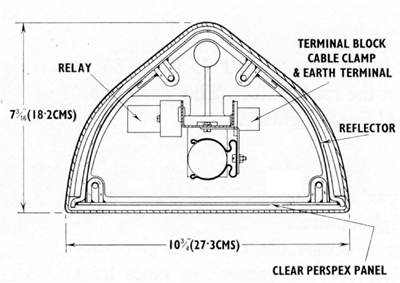|
The cut-off Amberline is an enclosed lantern for one 200 watt Mazda Sodium Linear discharge lamp.

Application
The cut-off Amberline may be mounted at heights between 25 and 35 ft. at 80 to 140 ft. spacing according to the intensity
required on the road surface. The Amberline is accepted by the Ministry Of Transport for Class 'A' road lighting.
Specification
The lantern consists of an end casting and a 'Perspex' enclosure which houses specular magnesium aluminium alloy reflectors for
accurate light control.
The end casting, aluminium alloy (LM6), has a removable cover to give easy access for re-lamping and normal maintenance. The cover is
secured in place by a stainless steel coin slot screw and a safety chain is fitted to allow the cover to hang freely when it is removed
for maintenance.
The casting carries the lamp support channle assembly which includes a terminal block, cable clamp, earth screw and thermal relay. At the roadway
end of the support channel a retractable bi-pin lamp holder (72/01013) is fitted and a metal stirrup is provided to act as a guide during
re-lamping operations. At the lantern access end a push on bi-pin holder (72/01018) is fitted on short flexible leads to allow slight
freedom of movement.
The 'Perspex' enclosure comprises a black 'Perspex' canopy cemented to a flat clear 'Perspex' panel. The specular magnesium aluminium alloy
reflectors are fitted within the canopy and the entire 'Perspex' assembly is securely held in position by four 'J' bolts passing through
'Perspex' blocks which are firmly bonded to the walls of the enclosure.
The top of the casting includes the side entry facility and the outteach bracket is secured by 'Allen' screws located under the canopy for
protection and appearance.
Light Distribution
Specular aluminium alloy reflectors housed in an opaque 'Perspex' canopy give a cut-off distribution as defined in British Standard
1788 (revised).
Maintenance
Normally, only for lamp replacement at 4000 hours. This is a simple operation as the lamp is withdrawn through the rear after opening
the end plate.
Product Number 51/71200
Weight 17 lb. (7.7 kg)


Weatherproofing
All 'Perspex' to metal, and metal to metal, joints are rendered weatherproof by the use of Neoprene gaskets which are used for
sealing the 'Perspex' envelope to the end casting and also between the access cover and the main body casting. Breathing
can only take place through the wiring entry and the lantern should therefore remain clean in service without attention for
exceptionally long periods.
Allen screws secure the lantern to the bracket and, enclosed by the lantern, are protected from atmospheric corrosion.
Mounting
Side entry for 1¼" plan B.S.P. 4" long.
Control Gear
One 61/22116 leak transformer, tapped 200/250V, and one 62/63206 capacitor for power factor correction to 0.85 or better, are
required in the base of the column. Dimensions of the transformer are 8½" long, 4½" wide, 4½" deep. One 61/72401
thermal relay is fitted in the lantern. Total circuit watts 235 approx.
The Company reseve the right to change without notice the design or the specificaiton of equipment included in this
publication.
|



